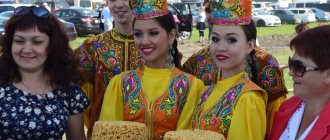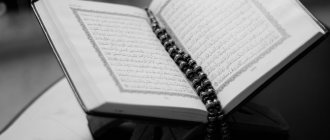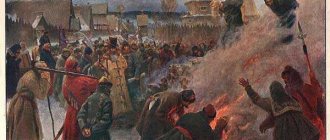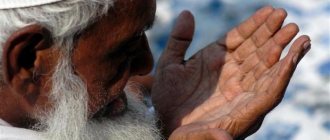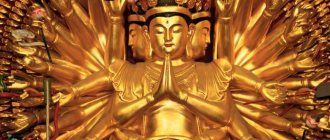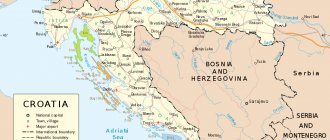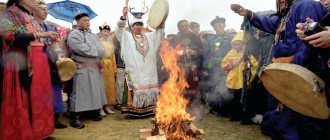You can often hear that Ossetians are considered Christians. Others note that there are also Muslims among them, and therefore one cannot be so clear-cut. But what is truly remarkable is that the Ossetians themselves consider this a controversial issue. The modern religious views of the residents of both South and North Ossetia are greatly influenced by the culture of this people and the features of their ancient beliefs.
Ossetians in ancient times
Since ancient times, the Ossetian nationality has had different names. For example, they called themselves “iron adam”, and the country in which they lived - “Iriston”. The Georgians called them “ovsi”, and the country, accordingly, “Ovseti”.
Since the first millennium AD, people lived in the North Caucasus, in the Alanian kingdom. Over time, the Ossetians were greatly pushed out by the Mongols and Tamerlane’s troops, after which their way of life changed greatly. Having fallen under the influence of Georgia, they began to change their lives, and with it their religious affiliation. It became quite difficult for the people to live under the new conditions and had to settle in the harsh mountains.
People who observed the life of the Ossetians from the outside sympathized with them very much, since their country was closed and inaccessible to the outside world due to mountains shrouded in ice and snow, and also due to the presence of rocks and fast-flowing rivers. Due to the environment, Ossetia's fertility is low: apart from cereals such as oats, wheat and barley, virtually nothing will be born there.
Ossetians, whose religion has been considered Christian since ancient times, are today only considered as such because of their observance of Lent, veneration of icons, and faith in priests and churches. They have nothing more to do with Christianity. Previously, Ossetians revered many gods of the natural elements and looked for parallels between the Christian pantheon and saints in Islam. Very often they made sacrifices to Christian saints, such as Nicholas the Pleasant, St. George the Victorious, Archangel Michael and others.
Revered deities of the people
The folk religion of Ossetians is monotheistic. God is called Khutsau. He is the only creator of the world. And he controls everything, including the spirits, to whom, according to tradition, one should direct one’s requests.
Here are some of the revered patrons of the people:
- Wacilla is the spirit of thunder and light. It was originally known as Thunderer, but with early Christianity it was changed to Wacillus, which is the name of the biblical prophet Elijah. If a person was killed by thunder, it was believed that he had angered Huacillus.
- Uastirdzhi - sometimes called Saint George
- . He is the patron of husbands, travelers, young and old, the scourge of thieves and murderers. He is the most famous and most respected spirit of the Ossetian people in both North and South Ossetia.
- Tutir is the patron and ruler of wolves.
- Falwara is the protector of livestock. He is considered the kindest and most peaceful spirit.
- Afsati is the ruler of wild animals and the patron of poor hunters. He is usually depicted as an old man with a long white beard, sitting on a high mountain. In the old days, hunters would take three pies with them to offer to Afsati for good luck.
- Barastyr is the patron saint of dead people and the afterlife. He cares for people in both hell and heaven.
- Don Bettir is the ruler of the water, who lives in the water and owns fish. He is the patron saint of fishermen.
- Rynibardug is the spirit of disease.
- Madi Mairam is the patroness of women who is closely associated with St. Mary of the Christian religion.
- Sau Dzuar is the patron of the forest, who protects it from fire.
- Safa is the creator and patron of the nadochna chain, especially revered in connection with the value of the home for the family.
Of course, this is not a complete list. But it shows what role spirits and saints played in people's lives. Legends were told about spirits and patrons, sacrifices were made to them, they tried to appease them with rituals and holidays, special places were dedicated to them and sanctuaries were made. Ossetian mythology is permeated with exciting stories about the amazing life of the patrons of the people.
The emergence of Christianity in Ossetia
How did Ossetians become Christians? This religion came to them from Georgia in the 11th-13th centuries - this is according to official data, but not many people know that the people became acquainted with this faith much earlier. And she gradually entered their lives.
Back in the 4th century, South Ossetians adopted Christianity from western Georgia. But due to the weakening of faith after Lazik’s departure to the Persians, religious teaching did not spread further. Again Christianity asserted itself during Justinian’s campaign against Ossetia and Kabarda. This happened already in the 6th century. During Justinian's activity as a missionary, churches began to be built, and bishops came from Greece. It was during this period that Ossetians became accustomed to elements of the Christian cult and rituals. But already in the 7th century, the campaigns of the Arab conquerors began, which again stopped the development of Christianity.
For many centuries, religious life in Ossetia remained unstable. There were Ossetian Christians and those who adhered to the Islamic faith. Both branches became family to them.
Christianization in the Alan Empire
In the VI-VII centuries. Byzantine preachers appeared in Alanya, introducing features of Orthodoxy into their life and religion. The process of Christianization was one of the forms of relations with Byzantium, which pursued its own political goals. With the help of Christian bishops and priests, the empire began to expand its sphere of influence and power over these lands, working through local leaders through bribes and gifts, endowing them with various titles.
This happened in order to reduce the danger of an attack by nomadic tribes on the borders of Byzantium, which at that time inhabited the steppe and mountainous regions from the North Caucasus and Maeotis to the Caspian Sea. Therefore, the empire tried to provoke conflicts between them, and also tried to enter into an alliance with the steppe peoples in order to resist Iran.
The strategic position of the territories of the Alanian state contributed to the empire’s interest in its population, whom they, although they considered barbarians, sought to strengthen relations with them with the help of Christianity. Until the middle of the 7th century. independent Alania was an ally of Byzantium in confronting the Arab caliphate in the Caucasus.
After the end of the Arab-Khazar hostilities, the political influence of the Khazar Khaganate was greatly strengthened, which was Alania’s tactics in order not to fall under the rule of the Arab conquerors.
Study of Ossetian Faith
For many years, this people (Ossetians) adhered to both Christianity and Islam. Despite the differences between confessions, the rituals were carried out together. In addition, they were interconnected with ancient beliefs. Today North Ossetia has communities of 16 faiths. Researchers constantly monitor the inhabitants of the country and their religion; their attention is drawn to the form and degree of influence of faith on the people.
The beliefs of Ossetians began to be systematically studied after the annexation of Ossetia to Russia. It was the representatives of the Russian Orthodox Church who began to observe how the Ossetians, whose faith was unstable, lived and what traditions they preferred. And the first research began during missionary activity in the territory of this mountainous country.
Traditions
Ossetians are very hospitable and treat their elders with special respect. Ossetians have strict etiquette in family and social relations.
Every family has rules that all its members adhere to:
- when an elder enters the house, regardless of origin, every Ossetian considers it his duty to stand up and greet him;
- adult sons do not have the right to sit in the presence of their father;
- The host does not sit down without the guest's permission.
The custom of blood revenge has now been practically eradicated, but previously it was strictly observed, which constantly led to wars between families and, as a result, significantly reduced the number of the indigenous population of Ossetia.
Hospitality is still an outstanding feature of Ossetians today, especially in places less affected by European culture. Ossetians are very hospitable and sincerely welcome guests, they always welcome them with pleasure and generously treat them.
An Ossetian wedding includes many ancient and interesting customs and rituals. Previously and to this day, they must give a bride price - a ransom. The groom purchases and collects the ransom himself. The size of the bride price was determined by the dignity of the families that entered into kinship and the dignity of the bride herself. In some settlements in Ossetia, part or all of the bride price went as the bride's dowry.
Matchmaking plays a very important role. Respected people who are relatives or close friends of the groom's family become matchmakers. They come to the chosen one’s house 3 times, and only then do the parents give their consent to this marriage. Every time the matchmakers come home, the girl’s father must be polite and hospitable; he discusses the size of the bride price with the matchmakers. The days of the matchmakers' visit to the beloved's house depend on how quickly the groom collects the ransom. At the last meeting, the father of the bride speaks about his decision and the parties agree on the date of the wedding. It is believed that the matchmakers have finally reached an agreement with the girl’s parents when representatives of the groom’s family hand over the bride price to the bride. From this day on, the bride is considered engaged and her life begins to change. She can no longer visit various entertainment venues and especially meet the groom’s relatives there.
The next stage after matchmaking is a secret visit of the groom to the bride. The groom and his close friends must secretly come to the bride with an engagement ring, which is a symbol of engagement among all nations.
An Ossetian wedding is celebrated simultaneously in the house of the bride and in the house of the groom. This event is very fun, with all kinds of treats and a large number of guests, who usually attend from 200 people. Neighbors and acquaintances who were not invited personally can come to the wedding. At the same time, the owners are obliged to be hospitable.
For the festive table, a whole wild boar is traditionally roasted and homemade vodka and beer are brewed. There must be three pies on the table, symbolizing the sky, sun and earth.
The holiday begins at the groom's house, his friends must organize a retinue, which includes the best man, groomsman and named mother. They all go to the bride’s house, they are met there, they say a special prayer and are invited to the house for the festive table. The bride and her friends go to change into their wedding attire, which deserves special attention. The bride's dress is very elegant and unique in its beauty. It is decorated with handmade embroidery and various stones, which makes it very heavy. The dress covers all parts of the bride's body, even her neck and arms. The bride's headdress is decorated with silver and gold threads and framed with a veil in several layers. The veil and veil envelop the bride's face and make it invisible to strangers.
The bride's wedding cap with veil is the subject of a funny wedding ceremony - ransom. Many guests try to steal her, but the bride's relatives are closely watching this. In ancient times, it was considered a very bad omen if the bride’s hat fell into the wrong hands.
When the bride is dressed in her wedding dress, she sits in the wedding cortege along with the groomsman and best man. The bride's path is covered with sugar to make her life sweet. This should be done by the bride’s closest person, her mother. Along the way, the wedding cortege visits special holy places for prayer.
After the official part of the wedding, everyone goes to the groom's house. So that there are many children in the house, and a boy is born first, the bride is allowed to hold the baby in her arms. Weddings in Ossetia are very fun; from the very beginning of the celebration to the end, guests do not stop dancing national dances.
Unlike other weddings, the main difference in Ossetian weddings is the status of the bride. While all the guests are eating and drinking, the bride, with her eyes downcast, should stand silently in the corner of the festive table. She cannot sit down to eat or eat, but her relatives constantly sneak her treats.
The next important stage of the celebration is lifting the veil from the bride’s face. This must be done by the eldest member of the groom's family. This ritual is carried out towards the end of the celebration. Before this, the groom's relatives should lift the veil one by one and compliment the bride. At this time, the bride should stand silently and modestly.
When the bride's face is revealed, she gives her father-in-law gifts and treats her with honey. This suggests that life together will be sweet. Fathers-in-law, as a sign that they have accepted the bride, give her gold jewelry, thereby showing that they wish the newlyweds a happy and rich life.
Specifics of the Ossetian faith
Thanks to the traditional system of religion, for many centuries the opinion of the people developed, which was radically different from monotheistic beliefs. Their faith is open and capable of accepting completely new ideas and views from other faiths. The specificity of the Ossetian religion is the tolerant attitude of this people towards both Christianity and Islam. This is how they are - Ossetians. Whether there are Muslims or Christians around, it doesn’t matter to them. Despite the faith that family and friends accept, these people treat them the same, since at different times both Christianity and Islam were present in the life of the people.
Housing
Ossetian dwellings are whitewashed huts or mud huts, which are located on flat surfaces. In the mountains, where there is no forest or there is practically no access to it, the Ossetian dwelling, or, as it is also called, saklya, is built without the use of cement, from stones and one side is attached to the rocks. Sometimes the side walls are also fused with the mountain.
The main part of the Ossetian house is a large common room, a kitchen combined with a dining room, where food is prepared during the day. This is because Ossetians do not have a specific time for eating, and family members sit down at the table in turns: the older ones eat first, then the younger ones.
In the middle of the room there is a fireplace, above it, on an iron chain attached to the ceiling, a cauldron made of cast iron or copper hangs. The hearth plays the role of a kind of center around which the whole family gathers. The iron chain on which the cauldron hangs is the most sacred object in the house. Anyone who approaches the hearth and touches the chain becomes a person close to the family. If you take the chain away from the house or offend it in some way, this will become a very big offense for the family, for which there was previously a blood feud.
In Ossetian families, married sons were not separated from the family, so gradually, when the sons got married and brought wives into the house, new sakli and buildings were added to the house, including for household purposes. All buildings are covered with a flat roof, on which grain is often dried or bread is ground.
Manifestation of Christianity in Ossetia
The origins of the emergence of Islam in Alanya could not be studied as well as the advent of Christianity. There are some differences among scientists. The history of the Ossetians says that the faith of the sons of Allah began to spread in these lands in the 7th century, and other sources claim that Islam became “theirs” among the Ossetians only in the 18th century. Whatever it may be, the only thing known for certain is that the turning point occurred precisely after the annexation of Ossetia to Russia. Religious forms were dramatically transformed and adapted to the new rules. The Orthodox Church began to restore Christianity among the Ossetians, although it was not easy for the missionaries to achieve the desired result.
Ossetians treated baptism as an act necessary to join the Russian people, and were absolutely not interested in Christian dogmas and, naturally, did not adhere to rituals. It took several decades for Ossetians to come to know the faith of Christ and join church life. The creation of Christian schools, where public education took place, helped quite a lot in this.
Christianity and Islam began to develop in parallel after the annexation of Ossetia to Russia. Islam spread in some parts of the country, especially in the western and eastern regions. There people accepted it as the only religion.
History of the village of Lesken
In this sense, the history of the village of Lesken is interesting, because the lands on which this village was located were sold by the Kabardian princes for modest money to Muslim forced migrants. This area was beautiful, picturesque, on the very border with Kabardino-Balkaria - here and now the beauty is breathtaking: majestic mountain panoramas, velvety dense forests, luxurious valleys cut by the Lesken River, a proud tributary of the Tereke.
Muslims led by Khaev Mohammed, Dzandar, Islam and Goko moved here. Following the Khayev family, eighty-eight families moved here over the course of three decades, and the population of Lesken at the time of 1912 was six hundred and seventy-two people, all of whom were Muslims who treated their religious duties with extreme zeal. Families from the Donifar ummah, the Stur-Digor ummah, and the Makhchi Muslim society moved here. The first mosque on the banks of the Lesken River appeared in 1884, and Mohammed Karaev became its imam.
The Lesken Ummah became an example of a full-fledged Muslim community in the Caucasus, demonstrating how Ossetia considered Islam the most important religion for itself - they zealously adhered to fasting, weddings were not celebrated here until the imam formalized a nikah, and every adult man was required to attend daily mosque for prayers, and on Friday both women and children came to the holiday prayer. In Ramadan, tarawih were held - prayers, for which all Muslims who had reached the age of majority gathered. Each family annually made a sacrifice - they slaughtered a sacrificial animal, and the meat was distributed into three parts: one of these parts was given to the poor, the second part was given to neighbors, and only the third part was kept by the family for itself.
A madrasah was built in Lesken, that is, a school in which the imam taught young men Arabic and fiqh - basic knowledge of Islamic law. The young men lived permanently at the mosque, they were called “sohtatæ”. Ossetia accepted Islam zealously, with a readiness to follow it for many generations of Ossetians to come.
Gradually, the mosque became too crowded and could not accommodate everyone, because the population of Lesken was actively growing. It was necessary to roughly divide the village into three parts, and for each part to build its own mosque and open its own madrasah. The large community, the jamaat, was also divided into three parts, each of these parts uniting eighty-five households. These were good brick mosques, very large and spacious by the standards of that time, their courtyards were surrounded by wooden fences. The madrasah was a house consisting of three or four rooms, around which fruit trees were planted, and benches were installed along the paths.
Residents of the village of Lesken made haji pilgrimages to Mecca. Before the revolution, more than forty people were able to do this, and upon their return, they began to enjoy great respect and authority among the local population.
Russia's influence on Ossetian religion
Already during the first Civil War, the Russian Orthodox Church was declared a stronghold of counter-revolution. Subsequently, there were repressions directed against the clergy. They lasted for several decades, churches and temples began to be destroyed. The Vladikavkaz diocese was already destroyed in the first 20 years of Soviet power. Ossetians, Christians or Muslims, did not have a single faith. And already in the years 32-37 there was a second wave of repressions, then both Christianity and the Muslim faith suffered. It was during these years that mass destruction and closure of churches were observed in Ossetia. For example, in Vladikavkaz, out of 30 cathedrals, only two have survived, which are still in use today.
In the 30s, the mosques that were located on the territory of North Ossetia were destroyed. The best clergy of various nationalities were persecuted.
It became very difficult for religious organizations to exist in Soviet times, but the Orthodox faith remained traditional and numerous for indigenous Ossetians. Only in the 90s did Islam begin to revive in Ossetia, communities began to be registered, and mosques were restored. The consequences of past attacks and raids are still felt today. The clergy do not have any professional training, and there is practically no literature necessary for worship. This affects the work of Muslim communities. There were attempts to invite young people who were educated in Egypt and Saudi Arabia, but they led to bad consequences, since along with them the Salafi teaching, unfamiliar and not inherent to the people, began to appear in the Caucasus.
Ancient Beliefs
Belief in God (the creator of this world), in the existence of the soul, patron spirits and the afterlife are closely intertwined with the cultural customs of the representatives of the ethnic group. Many Ossetian rituals and customs have religious roots.
Folk religion has been influenced from outside for many centuries, changing and merging with introduced elements of other practices.
Paganism
The ancestors of the Ossetians left no temples, no idols, no books, or other religious shrines. The basis of the ancient belief is the unification of man with nature. Therefore, it was customary to spend all holidays in the open air (in the forest, in the mountains, near the river).
In the ideas of the ancient Ossetians, there was no need for religious leaders. Instead, the people revered the elders, who passed on wisdom and traditions to the young.
The religion of the Ossetians was based on the recognition of one God, but they still made sacrifices to patron spirits.
They believed that God was more than just a fulfiller of people's requests. And the spirit is an integral part of nature, which can be used for your benefit if you know how to do it.
All religious holidays were joint feasts. People of different classes gathered at a common table. Conversations about spirits, mythical ancestors and social problems and affairs took place over traditional dishes.
Interestingly, the Ossetian pies known to many have religious significance. Three pies are served on the table on family and religious holidays and prayers are said in a certain sequence.
Orthodox traditions
Ossetia became acquainted with the Orthodox religion a very long time ago.
In 2014, the Orthodox world celebrated the 1100th anniversary of the baptism of Alanya. According to the official version of the Alan Diocese of North Ossetia, in the 10th century, Bishop Peter from Constantinople (Byzantium) baptized the Alan people.
On the other hand, many historians believe that the first acquaintance with Christianity was much earlier. They learned about the teaching on the territory of the Sarmatians and Scythians from the apostles Andrew the First-Created and Simon the Canaanite back in the 1st century AD. e. Their sermons were received with enthusiasm, because they did not run counter to popular beliefs and cultural values of the population. On this fertile soil the Scythian (Tomitan) diocese was formed, and in Tauro-Scythia there were already five of them. Even before 451, twelve Alan (Scythian) bishops were known.
A new wave of Orthodox preachers in Ossetia appeared in the 8th century. Then the Orthodox Synod of Russia set tasks for the missionaries, which included both strengthening Orthodoxy and establishing political ties between states.
Modern Ossetia
In the modern world, due to the transformation of religion, its new forms began to appear, which are very far from traditions. Ossetian culture is also undergoing changes. Under the guise of restoring the national Ossetian religion, there are attempts to create new movements that could become an alternative to Islam and Christianity. They are defined as non-pagan. Three such communities have already been registered in the Republic of Ossetia. They are trying to create a republican organization.
Today Ossetia has become a small state with a territory of almost 4000 square meters. km and a small population. After the August war with Georgia, Ossetians began to live in safety. The Georgians left them, but at the same time the people became very vulnerable. The borders of South Ossetia and Georgia are under strict control of the Russian authorities. Russia specifically created the Border Department for South Ossetia. After the war with Georgia, the country is recovering very slowly, and its capital Tskhinvali has only recently begun to truly reconstruct.
Almost all residents of the Republic of South Ossetia are Orthodox
Why is religion needed?
The majority of residents of the partially recognized state of South Ossetia are representatives of Russian Orthodoxy. The Constitution of South Ossetia enshrines the provision according to which “Orthodoxy is the basis of the worldview of the Ossetian people.”
In 2003, an agreement (Concordat) was signed between the Alan diocese and the Republic of South Ossetia, signed by Bishop George (Puhate) and President Eduard Kokoity.
Ossetian priesthood and Bishop George (Pukhate) in Tskhinvali. The majority of residents of the Republic of South Ossetia are Orthodox. Photo: upload.wikimedia.org
Since 1943, the territory of the republic has been nominally part of the Nikoza and Tskhinvali diocese of the Georgian Orthodox Church.
As a result of the Georgian-South Ossetian conflict (since 1989), the Georgian Patriarchate lost the possibility of archpastoral care of the South Ossetian diocese.
Thus, the real positions of the Georgian clergy in the republic are extremely weak, which is due to the sharp rejection by the South Ossetian people of everything that is associated with Georgia.
2016
this year the construction of a Russian Orthodox Church church began in Ossetia
The priesthood of the South Ossetian diocese was forced into one of the Greek Old Calendar jurisdictions - the “Synod of Opposing”, recognizing the sacraments of local Orthodox churches. As a result, the Ossetian priest George (Pukhate) was ordained bishop.
In 2005, the Alan diocese was formed, which was initially part of the jurisdiction of the “Synod of Opposites”, and in 2014, together with the latter, entered the Synod of Chrysostomos. In April 2021, construction began on the temple of the Russian Orthodox Church in the center of Tskhinvali.
Map of military operations in the North Caucasus in August 2008. As a result of the Georgian-South Setian conflict, the Orthodox of South Ossetia lost contact with the Georgian Orthodox Church. Photo: upload.wikimedia.org
The political leadership of South Ossetia has repeatedly raised the issue of creating an independent Orthodox Church in Alania.
This is due to the fact that South Ossetian politicians object to the close relations that have developed between the Russian Orthodox Church and the Georgian Orthodox Church. Church hierarchs of Local Churches oppose the creation of such a church.
Pentecostals and communities of Ossetia
The situation with religion is quite peculiar. Only the Tskhinvali synagogue survived the atheism of the Soviet era, and is still in operation today, although it was converted into a Jewish cultural center. Nowadays, Jews began to leave Ossetia en masse and return to Israel, so the synagogue began to work for Ossetian Pentecostals. But now only the part of the building that was located in the back is operational, since the Jews held divine services in the front. There are six more Pentecostal communities throughout Ossetia.
Many representatives of the Ossetian intelligentsia accepted their faith, and for convenience, services are conducted in both Russian and local languages. Although Pentecostals are not officially registered today, they are absolutely free to develop and go about their business. This movement has taken a strong position in the social structure of the united church of Christians with the evangelical faith.
Ossetians today
A considerable part of Ossetians are still faithful to traditional beliefs. Different villages of the republic have their own sanctuaries and prayer houses. Today Ossetia is being restored and reconstructed. Due to the unsatisfactory socio-political situation, many citizens left the country, and those who remained live on low salaries. It is very difficult for people to engage in construction or purchase necessary food products, since Russian customs services continue to work according to the same scheme as before the war with Georgia. The Ossetian culture is not developing fast enough, so far they do not have the opportunity to get a good education and achieve something in life. And this despite the fact that Ossetia is rich in non-ferrous metals, they have wonderful timber, and the textile industry is being revived. The state can begin to develop and become one of the most modern, but this will require a lot of effort and a new government.
Turkish Ossetians practice Islam
Ossetians in Turkey are a national minority, mainly represented by descendants of immigrants from North Ossetia in the second half of the 19th century. Most Turks profess Islam, so this religion has become the main religion for North Ossetian Muslims who emigrated to the country.
The main reason for their resettlement here was muhajirism - the massive and deliberate resettlement of Muslims to a Muslim country from non-Muslim countries where Muslims are a minority.
Representatives of the Ossetian and other Caucasian diasporas in Turkey protest against the Georgian attack on South Ossetia (Istanbul, August 13, 2008). Photo: upload.wikimedia.org
Despite the fact that Turkish Ossetians have been living outside the Territory of North or South Ossetia for a long time, they still maintain their Ossetian identity.
According to various estimates, the Ossetian population in Turkey ranges from 20 thousand to 36 thousand people. Now most Ossetians live in large cities: Ankara, Istanbul and Izmir. Ossetians in Turkey still retain their Ossetian identity. In 1989, the Alan cultural and charitable foundation was created. It is currently headed by Remzi Kanukati (Remzi Yildirim). In Ankara and Istanbul, this foundation has opened courses for children to study the Ossetian language.
40 thousand
so many Ossetians live permanently in Turkey
Nowadays, approximately 40,000 Ossetians live in Turkey. Some of the migrants returned back to Ossetia. This circumstance is connected with the fact that Turkey sought to colonize its sparsely populated provinces, which were not very suitable for habitation, with Muhajirs.
By leaving a comment, you accept the user agreement
Ossetian religion today
The history of a people is quite complex, and the same is true with religion. Who are the Ossetians - Muslims or Christians? It's very difficult to say. North Ossetia has remained closed to research and not much is known about it. Experts estimate that approximately 20% of the population in the north are faithful sons of Allah. Basically, this religion began to rise after the collapse of the USSR; many young people in North Ossetia began to profess Islam, mainly in the form of Wahhabism. Some people think that the clergy wants to control the religious activities of Muslims, and that they themselves are tightly controlled by the FSB, albeit behind the scenes.
Religion and nationality
South Ossetia became a haven for different peoples - Ossetians and Georgians, Russians and Armenians, as well as Jews. Indigenous people left the country in large numbers due to the conflict in the 90s and began to live in Russia. This is mainly North Ossetia-Alania. Georgians, in turn, left en masse for their homeland. The Orthodox faith, despite all the vicissitudes, began to prevail among Ossetians.
The connection between culture and religion
The Ossetian culture is constantly evolving, but the people try to adhere to ancient traditions and teach this to new younger generations. For the residents of Ossetia, it is absolutely unimportant what religion their relatives and neighbors have. The main thing is a good attitude towards each other and mutual understanding, and God is one for everyone. Thus, it does not matter who exactly the Ossetians are - Muslims or Christians. For spiritual and mental development, museums and theaters, libraries and educational institutions are open in the republic. The state is constantly working to improve the economy and other areas.
